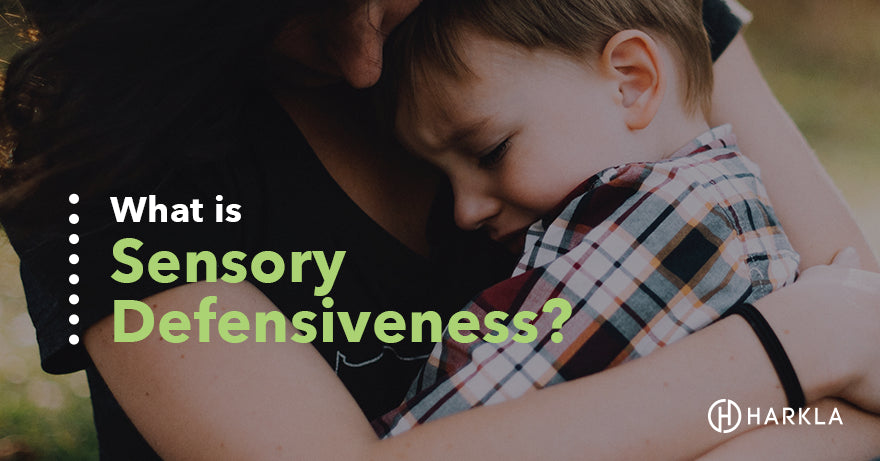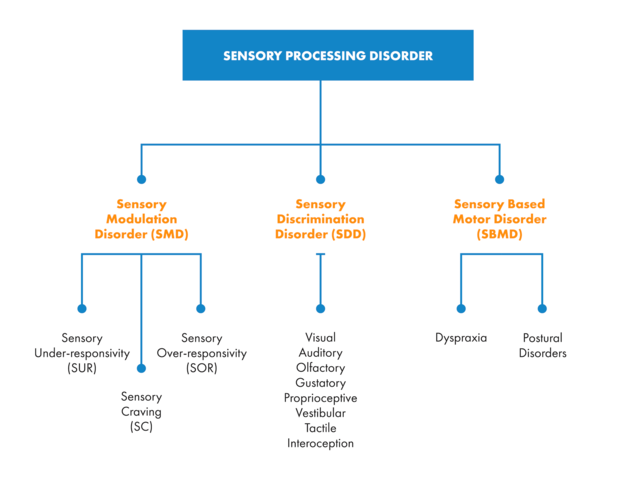Your Cart is Empty
Save up to 20% on all Harkla products & courses during Autism Acceptance Month! Click Here to See the Sale

To understand sensory defensiveness, we need to first look at Sensory Integration.
Sensory Integration is the process your central nervous system goes through when it takes information in from your body’s 8 senses, processes that information, and then responds accordingly.
When one’s central nervous system has difficulty processing any of this sensory information, the body’s responses are atypical and can be observed in motor, language, or behavioral skill difficulties. Occupational therapists diagnose these atypicalities as Sensory Processing Disorder or SPD.
When we talk about Sensory Processing Disorder (SPD), occupational therapists diagnose 3 subtypes of SPD:
It is likely that people with sensory processing dysfunction demonstrate a combination of symptoms from the subtypes, however, the symptoms we are focusing on in this article fall under one particular subtype: Sensory Modulation Disorder: Sensory Over-responsivity (SMD-SOR).

A child who presents with SMD-SOR has a low threshold for sensory stimuli - meaning, it doesn’t take much for him to be overwhelmed, overstimulated, irritated, or avoidant. This child is very sensitive to sensory stimuli. This oversensitivity or over-responsivity to sensory input limits the child’s willingness to play, explore, and feel safe or comfortable in his environment.
This over-responsivity can be referred to as “sensory defensiveness” because the child often defends himself (emotional or behavioral response), avoids, or tries to minimize the exposure to these sensations. Sensory defensiveness can be seen in any or all sensory systems and the child will avoid or become irritated by sensations, eliciting a physiological response that is referred to as “fight, fright, flight.”

Sensory defensiveness can affect social, emotional, and behavioral areas of a child’s life.
Some common complaints in daily sensory life can present as:
While these sensory stimuli may not affect the typical child or adult, sensory sensitive or defensive kids are bothered by the presence of (what they perceive or interpret as) noxious smells, tastes, sounds, touch, or movement.
Depending on the severity of your child’s sensory defensiveness, and which sensory system he over-responds to, the emotional and behavioral reactions could range from mild (i.e. fabric preferences, avoiding denim) to severe (i.e. throwing up with food textures, aggression when touched accidentally).
The best way to address sensory defensiveness is with a comprehensive, well-designed sensory diet that proactively supports your child’s sensory systems. It is best to consult your occupational therapist (OT) for a sensory diet plan that is tailored to your child’s individual needs, especially surrounding sensory defensiveness.
To watch an informational video on sensory diets, click here.
A well-trained OT will structure sensory diet activities in a certain sequence or “recipe” to foster organization, calm, and relaxation by targeting the release of neurotransmitters. For example, proprioceptive sensory input triggers the release of Serotonin, a neurotransmitter that helps with regulation. Proprioception also contributes to increased levels of dopamine which keeps us emotionally balanced.
Because of their calming, organizing, and regulating effects, deep touch pressure or proprioceptive activities are often used therapeutically to help modulate the over-responsive sensory child.
Within a sensory diet for sensory defensiveness, many occupational therapists will provide a recipe for deep touch pressure or proprioceptive activities that can include the Wilbarger Therapressure Protocol.
This therapeutic brushing program applies deep pressure touch input (not light touch) using a specialized plastic bristle brush to the arms, legs, back, hands, and feet. While a staple within many sensory diet recommendations for sensory defensiveness, it is critical that the recommending therapist, as well as the parents, be properly trained in the protocol so that the positioning of the Therapressure Device, an appropriate amount of pressure, direction and sequence of the ‘brushing’ be carried out correctly.
If you read our Ultimate Guide to Deep Pressure Therapy, you learned all about the physiological benefits and research that supports different therapeutic products and activities.
Weighted objects such as a weighted blanket or lap pad can support sensory regulation, as can compression garments and vests. Additional examples of deep touch pressure activities can include:

Sensory defensiveness is a term used to describe people who are over-responsive to sensory input and avoid or minimize their exposure to the sensations that are bothersome.
The physiological responses that occur when a child is sensory defensive can be minimized by deep touch pressure activities that provide proprioceptive input. Ideally, a sensory diet should be developed in consultation with your child’s occupational therapist to support his regulation skills proactively, but know that additional deep touch activities and strategies should be part of your sensory toolbox on-the-go.
For more information on sensory processing and creating a sensory toolbox, check out Harkla’s blog here.
Comments will be approved before showing up.


